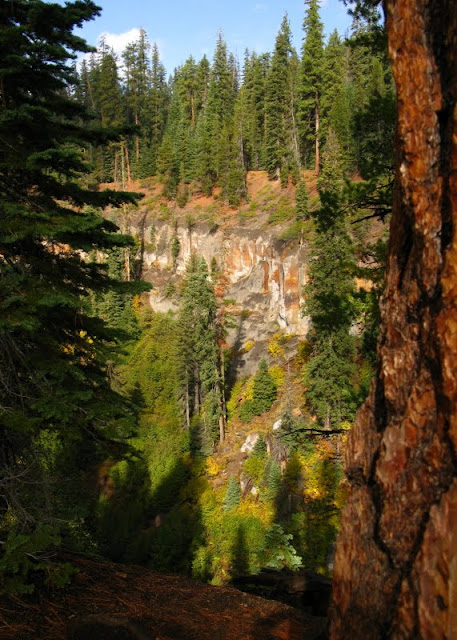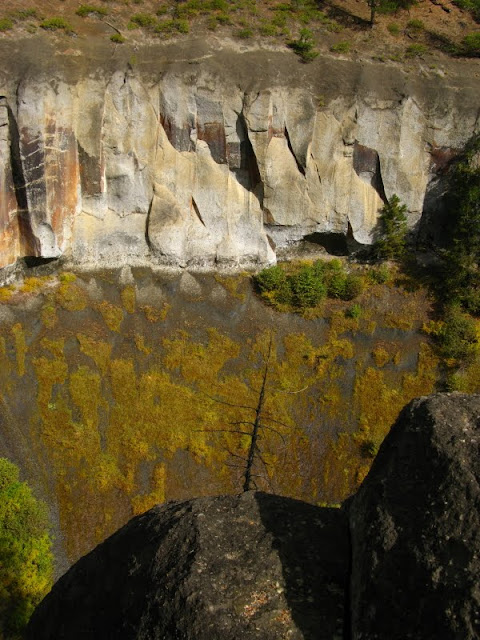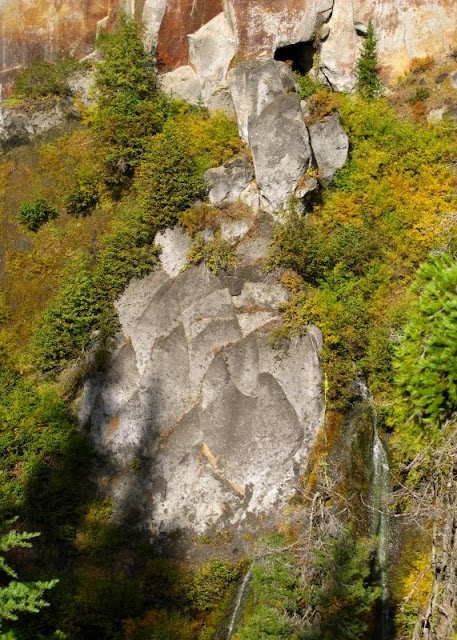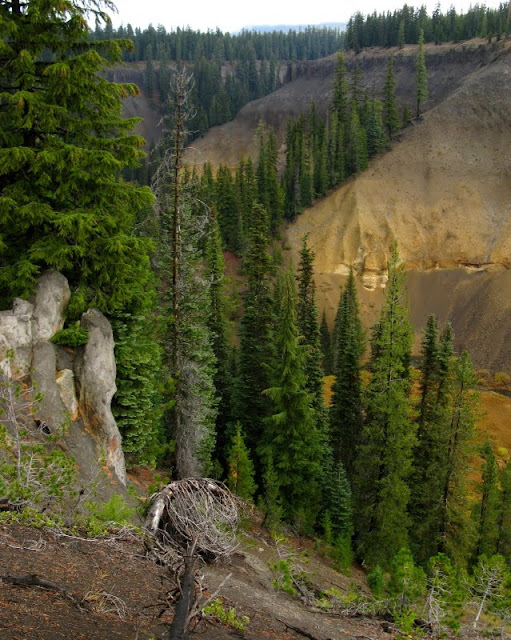 After making the unexpected turn onto Oregon Highway 62, I drove toward Crater Lake and stopped at the first pullout, the entrance to the Ponderosa picnic area (Google Maps location) - named, no doubt, for the magnificent Ponderosa pine trees that dominate the area. You can view a nicer version of this map of Crater Lake at Ponderosa, and it's also the first pit stop location after turning off from Highway 97.
After making the unexpected turn onto Oregon Highway 62, I drove toward Crater Lake and stopped at the first pullout, the entrance to the Ponderosa picnic area (Google Maps location) - named, no doubt, for the magnificent Ponderosa pine trees that dominate the area. You can view a nicer version of this map of Crater Lake at Ponderosa, and it's also the first pit stop location after turning off from Highway 97. I just love the trees you drive through on this part of the road!
I just love the trees you drive through on this part of the road! The second unmarked pullout past Ponderosa, located here on Google Maps has good views across the canyon formed by Annie Creek, along with some more wonderful trees. Look for trails, possibly made by geologists on former field trips.
The second unmarked pullout past Ponderosa, located here on Google Maps has good views across the canyon formed by Annie Creek, along with some more wonderful trees. Look for trails, possibly made by geologists on former field trips. The walls on both sides of the canyon are steep. In some places you can just barely see over the edge; in other places you can clamber down the slippery upper slopes - don't slide too far, there are columnar cliffs below.
The walls on both sides of the canyon are steep. In some places you can just barely see over the edge; in other places you can clamber down the slippery upper slopes - don't slide too far, there are columnar cliffs below. An upper layer of bedded, air-fall ash overlies an andesitic, scoria-rich ash flow deposit (called "andesite scoria" on signs in the area), which has weathered into crude columns. Cooling cracks in the andesite scoria do not appear to make it through the overlying deposits.
An upper layer of bedded, air-fall ash overlies an andesitic, scoria-rich ash flow deposit (called "andesite scoria" on signs in the area), which has weathered into crude columns. Cooling cracks in the andesite scoria do not appear to make it through the overlying deposits.UPDATE 23Jul2019: I'd like to clarify that the thin, light-colored layer just below the surface is the air-fall ash. Beneath that are brownish layers with only vague columnar formations. Beneath that are lighter colored deposits with obvious columnar weathering. The entire cliff section from the light colored columnar rock to the darker bedded layers form a thick zoned section of ash-flow tuff erupted from Mount Mazama during its climactic eruption about 7700 years ago. The entire deposit is zoned from lighter colored, more silicic, rhyodacitic material below to darker colored, more mafic, andesitic material above (CVO).
On to the next stop, the fourth unmarked pullout past Ponderosa (Google Maps location).
 It's here that I slid down the upper ash layer, down to the andesite scoria below. The green masses above the dark rock I have my foot on consist of trees and plants across the canyon.
It's here that I slid down the upper ash layer, down to the andesite scoria below. The green masses above the dark rock I have my foot on consist of trees and plants across the canyon. This is the same dark rock in the foreground, and now we can see the steep canyon wall on the other side of Annie Creek, with a dark talus slope below the columnar unit. I'm standing on the uppermost part of the andesite scoria.
This is the same dark rock in the foreground, and now we can see the steep canyon wall on the other side of Annie Creek, with a dark talus slope below the columnar unit. I'm standing on the uppermost part of the andesite scoria. Looking to the side from nearly the same vantage point, we can see some of the irregular shapes formed by erosion of the bedrock. This looks like a hoodoo to me.
Looking to the side from nearly the same vantage point, we can see some of the irregular shapes formed by erosion of the bedrock. This looks like a hoodoo to me. The canyon at this same unnamed overlook is really pretty, and includes this waterfall where a small side stream flows over the andesite scoria.
The canyon at this same unnamed overlook is really pretty, and includes this waterfall where a small side stream flows over the andesite scoria. More of the same canyon wall just to the left of the previous photo, with hanging gardens, trees growing on the side of the canyon, and layering in the columnar andesite scoria.
More of the same canyon wall just to the left of the previous photo, with hanging gardens, trees growing on the side of the canyon, and layering in the columnar andesite scoria. And here I've finally found some incipient pinnacle shapes. This is about as good as it gets below Annie Falls. The road to The Pinnacles overlook, with rock that looks like this, was closed.
And here I've finally found some incipient pinnacle shapes. This is about as good as it gets below Annie Falls. The road to The Pinnacles overlook, with rock that looks like this, was closed. Possibly the cooling cracks have extended from the columnar scoria a little ways into to the overlying ash deposit here, forming these miniature pinnacles.
Possibly the cooling cracks have extended from the columnar scoria a little ways into to the overlying ash deposit here, forming these miniature pinnacles. This is Godfrey Glen, which can be seen from the Fossil Fumaroles overlook (Google Maps location). The upper ash is the tree-covered slope former above the dark unit of the andesitic scoria ash-flow deposit. Columns and pinnacles are especially prevalent near the top and middle (or bottom?) of this dark unit. The golden brownish rock below consists of a dacitic pumice flow deposit. All this rock was erupted during the climactic eruption of Mt. Mazama - 6,845±50 carbon-14 years B.P. or about 7,700 years ago (Bacon, 1983) - which then collapsed to form the caldera that is now filled by Crater Lake.
This is Godfrey Glen, which can be seen from the Fossil Fumaroles overlook (Google Maps location). The upper ash is the tree-covered slope former above the dark unit of the andesitic scoria ash-flow deposit. Columns and pinnacles are especially prevalent near the top and middle (or bottom?) of this dark unit. The golden brownish rock below consists of a dacitic pumice flow deposit. All this rock was erupted during the climactic eruption of Mt. Mazama - 6,845±50 carbon-14 years B.P. or about 7,700 years ago (Bacon, 1983) - which then collapsed to form the caldera that is now filled by Crater Lake. Weird, hoodoo shapes in andesite scoria in the foreground.
Weird, hoodoo shapes in andesite scoria in the foreground. A couple pinnacles across the canyon. Annie Creek can be seen in the bottom of the photo.
A couple pinnacles across the canyon. Annie Creek can be seen in the bottom of the photo.Some References:
Bacon, 1983, Eruptive History of Mount Mazama and Crater Lake Caldera, Cascade Range [ref only], U.S.A.: Journal of Volcanology and Geothermal Research, v.18, p.57-115.
Decker, R., and Decker, B., 1995, Road Guide to Crater Lake National Park: Double Decker Press, 47 pp (?).
Williams, H., 1942, The Geology of Crater Lake National Park, Oregon With a reconnaissance of the Cascade Range southward to Mount Shasta: Carnegie Institution of Washington Publication 540, 162 pp.
Crater Lake & Mount Mazama, at the Cascades Volcano Observatory (CVO) website.
Mazama Ash, at the CVO website.
Summary of the Eruptive History of Mount Mazama, at the CVO website.
5 comments:
mmm, sounds like a lovely place. Great photos. I'm planning a trip to Oregon next year, this might just be one of the places I'd like to go
I think it's well worth the visit - and wait til you see the Crater Lake photos! (And contact me when you go, wd love to meet.)
Silver Fox: Lovely photos! Sounds like you had a wonderful trip back home. Looking forward to your post on Crater Lake.
It's finally up, yay!
I will certainly let you know if I ever get serious plans to come close to your neighbourhood
Post a Comment